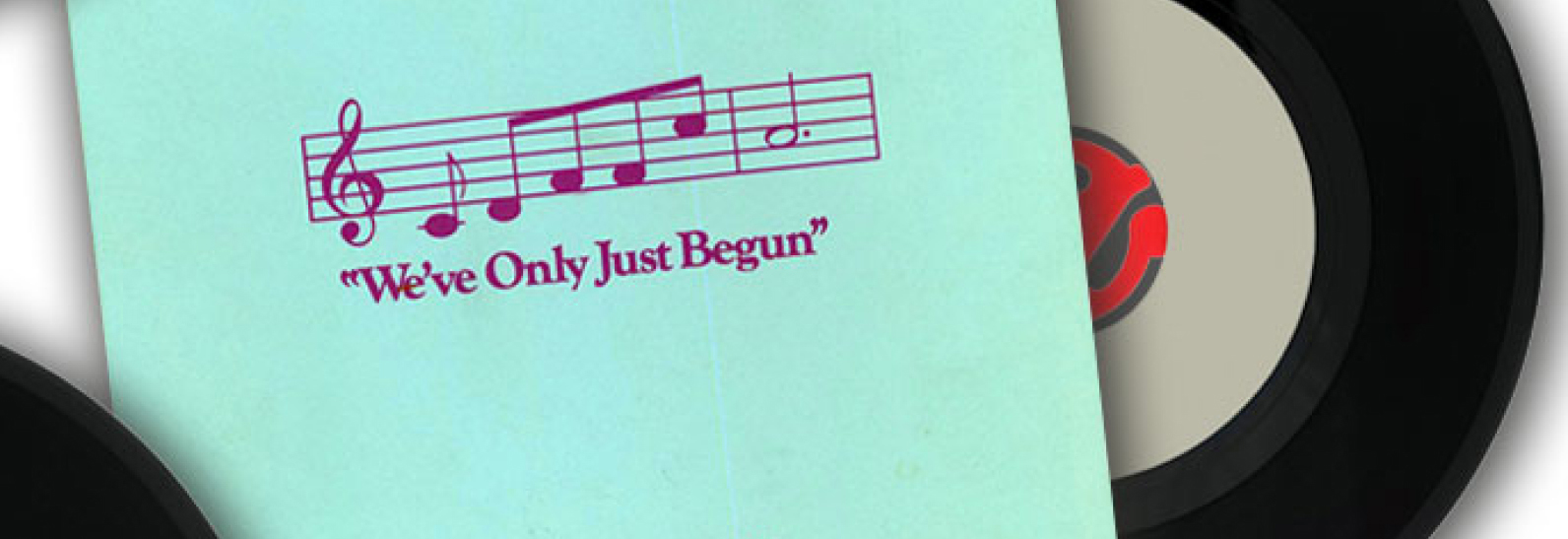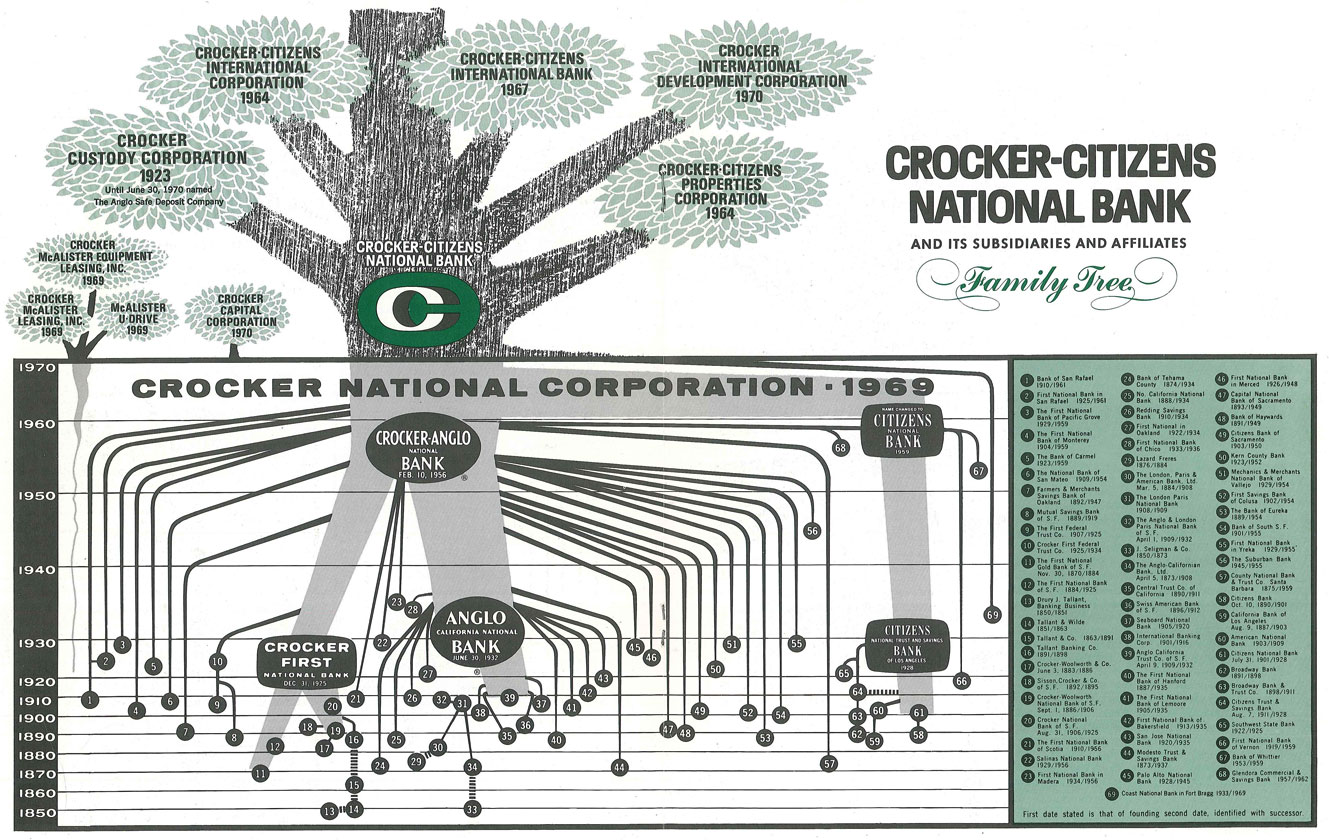The bank commercial that became a hit song

The bank commercial that became a hit song
A small church stands at a distance in the middle of flat, dry terrain on a clear day. Tall grass in the foreground sways in the breeze. The shot transitions to a closeup of a bride’s face that is barely visible beneath a veil.
[Background music begins: mellow ballad]
We’ve only just begun, to live
(When lyrics begin with a male vocalist “We’ve only just begun, …,” the shot changes to a male priest standing between the bride and groom. Only the backs of the bride and groom are visible. The priest is officiating their wedding and speaks inaudible words to the couple. When lyrics say “… to live, …,” the shot changes to a closer frame of the bride, groom, and maid of honor. The camera pans left across their faces as they listen to the priest who is now offscreen. The shot then changes to a closeup profile of a young girl who is watching the wedding intently.)
So much of life ahead
(When lyrics say “… So much of life, …,” the shot changes to two wedding guests, an older man in the foreground and an older woman behind him. The woman touches her face with her gloved hand. The shot then changes to the bride. The camera pans up quickly to her face and then zooms into a tight shot of her blue eyes.)
We’ll find a place where there’s room to grow
(When lyrics say “… We’ll find a place where, …,” the shot changes to a closeup of the groom and best man’s faces, quickly zooms out, and then changes to a close up of the groom’s hands placing a ring on the bride’s finger. The shot changes to the bride and groom releasing their hands, and as the background comes to focus, various wedding attendees are seen looking at the couple, including a young boy in the center of the shot.)
We’ve only just begun
Before the rising sun, we fly
(When lyrics say “… We’ve only just begun, …,” a close shot of the bride and groom kissing comes to focus. When the lyrics say “… rising sun, …,” the shot changes to the faces of an older man and woman. The woman wipes tears with a tissue as the man looks at her. When lyrics say “… we fly, …,” the shot changes to a visibly happy bride and groom walking down the aisle together after their ceremony. The shot changes to a closeup of the bride receiving a kiss on the cheek from an older woman. After, they smile and exchange inaudible words.)
So many roads to choose
(When lyrics say “… roads to choose, …,” the shot changes to the bride and groom interacting with an older woman and young boy. The woman kisses the cheek of the groom, inaudible words are exchanged, and then the woman turns to kiss the cheek of the bride. The shot then changes to the bride and groom who are now in plain clothes and coming out the church hand in hand. Their guests cheer and throw rice at them.)
We’ll start out walkin’ and learn to run
(When lyrics say “… We’ll start out walkin’, …,” the shot changes to a closeup of fencing and tall grass with unfocused car headlights beaming through in the background. The front of the car comes into focus and becomes the subject of the frame. The shot pans left as it follows the moving car. The car has its windshield wipers on and is passing by a farm with fenced in sheep. The car begins to disappear to the left of the screen.)
Yes, we’ve just begun
(When lyrics say “… Yes, we’ve just begun, …,” the shot changes to a closeup of the groom as he drives. Sun highlights his face and moving windshield wipers are seen unfocused in the foreground. The shot then changes to the bride who is sitting next to the groom and speaking, inaudibly, to him while the windshield wipers remain on. The camera pans slightly right towards the groom.)
We’ve only just begun
(When lyrics say “… We’ve only just begun, …,” the shot changes to a wide angle of the open road, and the front of the car is seen in the distance slowly coming forward. The road is surrounded by rocky, elevated terrain and the sky is not visible.)
(Background music continues: The narrator begins to speak.)
You’ve got a long way to go.
(When the male narrator says, “You’ve got, …,” the words “You’ve got a long way to go” are in the center of the screen transposed over the driving car. The words then disappear.)
We’d like to help you get there.
(When the narrator says, “We’d like, …,” the words “We’d like to help you get there” are in the center of the screen transposed over the driving car. The scene then fades into the next.)
The Crocker Bank.
(Text on screen: CROCKER BANK. When the narrator says, “The Crocker Bank, …,” the text onscreen is visible. The Crocker Bank logo, seven triangles surrounding a green circle, is directly above the onscreen text.)
[Background music fades and scene ends]
It was 1970 when California’s Crocker-Citizens National Bank realized it had a problem with name recognition. The bank ran an advertising campaign for its checking account in the 1960s, and was discouraged to learn that some potential customers saw the ads and called competitors also named “Citizens.” After a series of mergers and name changes, people had trouble distinguishing it from other banks. Some people recognized the Crocker name but remembered it for its commercial and trust services. They saw it as a bank for businesses, not households. Over time, Crocker had become a bank fixated on retail banking. It had been investing in innovative services like credit card accounts and colorful checks with lines of credit. It opened and expanded its branch network to have 280 offices across California. This was in response to California’s growth; it became the most populous state in the nation in 1970.

Crocker had more than 1.3 million deposit accounts in the competitive California market, but it knew it needed to attract new customers to survive. A large cohort of baby boomers (those born between 1946 and 1964) were growing up and needed their first car loans, mortgages, and savings accounts. It had a lot of work to do to convince customers that it was a new bank with the services people needed.
Crocker turned to its advertising agency to create an ad campaign that would attract younger customers. The agency appointed Hal Riney to figure it out. While later recognized as one of the best advertising executives of his time, Riney was just starting out his career. He had a vision for a new kind of commercial: a warm, storytelling video with a song and the bank’s name, with no additional product information
In a 2009 documentary, “Art and Copy,” Riney remembered the moment he pitched his idea: “So I went to the president of the bank, and I said, ‘You know, I think what we ought to do is we ought to take some of your money and go out and get a whole bunch of songwriters to write a song about young people and their lives and how their lives are changing and things like that. And I can’t tell you what the song is, because I’m not a songwriter. And I can’t even tell you what the commercials are, because I can’t tell you that until we do the song.’ He said, ‘That’s pretty vague …’”
Despite any misgivings, the bank went ahead with Riney’s creative vision.
Riney hired songwriter Paul Williams and music composer Roger Nichols. Despite what he told Crocker management, Riney’s ad team had already created a slogan and focus for the commercial. Williams and Nichols were given the slogan — “You’ve got a long way to go. We’d like to help you get there” — and an explanation that the commercial would feature a couple getting married. They wrote the music and lyrics in an afternoon.

The commercial launched in 1970 and became an immediate hit. Branches were flooded with requests to use the song at weddings and graduations. Deposits and loan volume increased. Brand recognition improved with younger customers. The ad’s success was credited with its simplicity. By using no product or service announcement, it was a revolutionary new type of commercial. It focused on the customer, not the bank. As Williams reflected at the time: “We added a song, not a sales pitch. And the song has universal appeal. … It says something meaningful to people, regardless of time.”
The commercial caught the attention of one young man, singer Richard Carpenter. In 1970, he asked Williams and Nichols for the music. On September 12, 1970, the Carpenters released their album “All of My Life” which included a version of “We’ve Only Just Begun,” sung by Karen Carpenter, that peaked at No. 2 on the charts in November 1970.
“We’ve Only Just Begun” was a turning point song for almost everyone involved. Its popularity helped the Carpenters win the Best New Artist Grammy in 1971. It was the first hit single for Williams, who went on to have a long list of popular songs, including “Rainbow Connection” for The Muppets and “You and Me Against the World.” Nichols went on to become a Grammy Award-winning engineer and music producer.
The song had a lasting legacy for the bank as well. While the commercial only ran for a short period in California markets, people across the nation remembered the song and its connection to Crocker Bank for years.
Where does “Crocker” come from?
Charles Crocker is best known for his role as one of the “Big Four” investors in the Central Pacific Railroad, the western half of the nation’s first transcontinental railroad. He was also a banker. He served as president of the First National Gold Bank of San Francisco from 1876 to 1883. Then he decided to open his own private bank with a group of investors. Started in 1883 with $500,000 capital, Crocker-Woolworth & Company went on to become one of San Francisco’s leading commercial banks. In 1986, Crocker Bank merged with Wells Fargo.